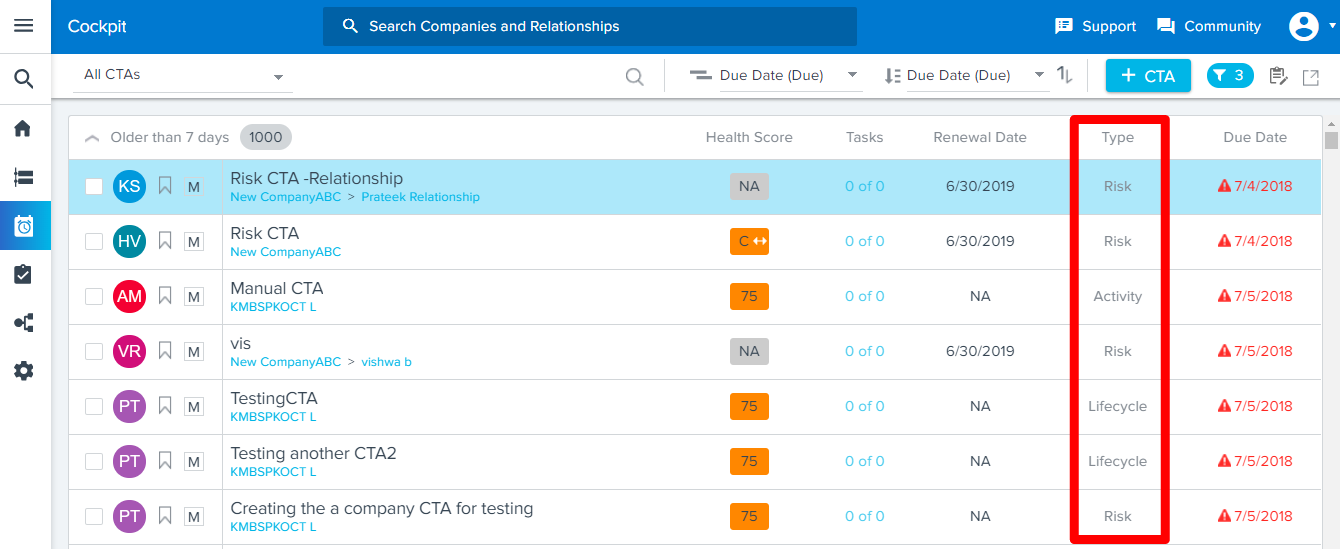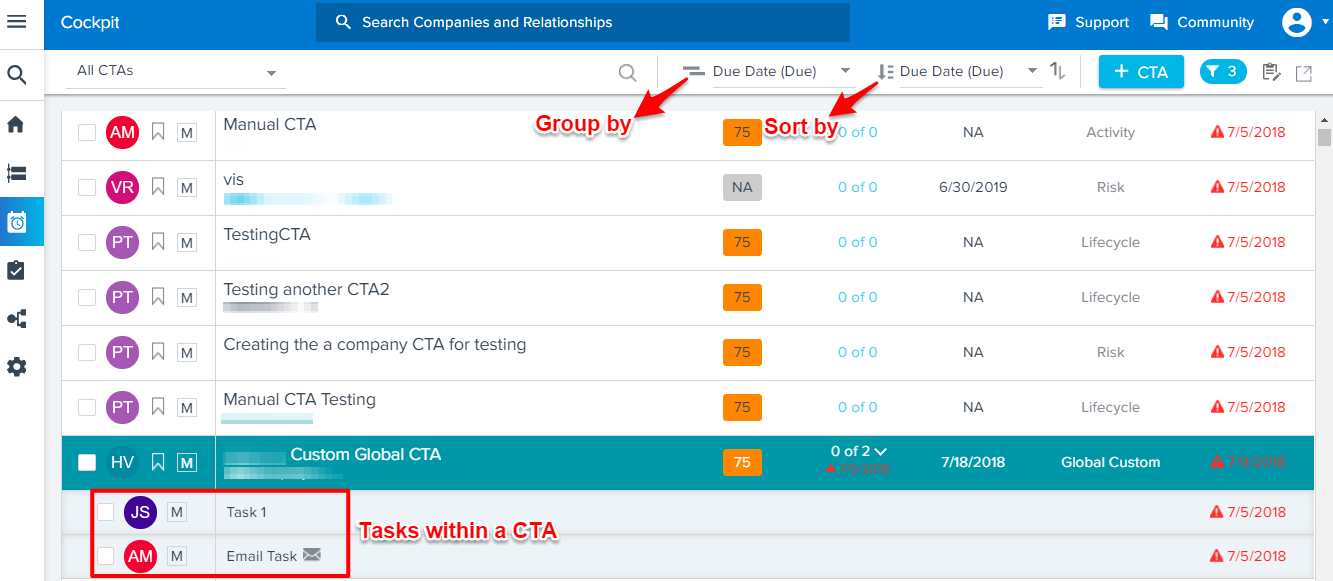Archived CTAs, Tasks, and Playbooks Overview
Overview
Cockpit is the day to day workspace for CSM's and AM's, which helps users drive revenue and mitigate risks faster from a centralized location. Calls-to-action, or CTAs are tied to customers and are the backbone of the Cockpit; CTAs typically include tasks for the CSMs to complete. CSMs can group and sort CTAs by due date, status, types and reasons, and more in the Cockpit List View. CTAs are data or lifecycle driven alerts, and can be created manually, but more often are triggered by business rules that analyze usage data, ex: Drop in Usage, Support Cases, Change in Sponsor, and Survey Results, etc.
For each CTA that appears in the CSM's Cockpit, a prescribed playbook of best practice tasks can help guide the CSM through the right steps. Playbooks help disseminate and standardize best practices across the organization.
CSMs can also access the timeline activities from the CTA detail view to log an activity (for a particular company or relationship, and tied to a specific CTA) on the Timeline sub-tab.
Before CSMs can begin creating or managing CTAs in Cockpit, the Admins must configure CTA Settings (Types, Reasons, Priorities, etc.), define Standard Cockpit Layouts, etc. For a customer's perspective on what makes a good CTA, click here.
For more information on how to configure Cockpit, refer to Configure Cockpit: CTA Types, Reasons, Priority, etc.
The benefits of using Cockpit include:
- Standardization - ensure that you have a single source of truth for your team’s action items
- Collaboration - enable collaboration by making your action items, and associated updates, available to others in your organization
- Integration - link your action items to your Opportunities, Activities, Contacts, Cases, and much more
- Automation - configure rules to automatically trigger action items based on customer data or time factors
- Reportability - report on your action items to communicate progress to your team
CTA Types

Data-driven CTAs allow CSMs to be more proactive and targeted in their actions. A call to action can be categorized as a Risk (of churn), Opportunity/Expansion (positive trend), Event (lifecycle-based), Activity or another custom CTA type. Here are some examples:
- Risk: Represents negative trends with customers. Examples include Usage dropped by 50% in last month; or, Your customer’s executive sponsor left the company or Negative NPS® survey score.
- Opportunity/Expansion: Positive trends with customers. Examples include high NPS® score; or, Customer agreed to do a case study or be a reference, high page views or product usage.
- Event/Lifecycle: Lifecycle-based and typically scheduled events. Examples include training events, EBR/QBR, and renewal meeting.
- Activity: Tied to 360 Timeline Activities. Activity is generally used as the default CTA type for CTAs created from the Timeline feature automatically. Users can also create CTAs of this type from the Cockpit page.
The 5th CTA type is an Objective. Success Plans combine a new CTA type with a new Object to create Plans comprised of Objectives and Tasks. Success Plans live on the 360 page and can be assigned ownership just like CTAs. CSM’s can use Success Plans to develop a plan for their company’s internal goals, to maintain and grow an company, or tackle a project. Success Plans are also a great way to collaborate with customer stakeholders, align on what’s most important for the success of the customer, and craft a strategic plan.
Note: Admins cannot edit the Risk and Objective CTA types. Admins can modify the name of the Opportunity/Expansion, Events/Lifecycle, and Activity CTA types, as well as create custom CTA types
To create custom CTA types, refer to Create Custom CTA Types.
Access CTAs and Tasks

In the Cockpit tab, you will see the List View (default view) of all the CTAs and tasks with group and sort options.
Note: Objective CTAs appear in the List view, but to Create Success Plans and objectives, you must navigate to the Customer 360 page.
| Net Promoter®, NPS®, NPS Prism®, and the NPS-related emoticons are registered trademarks of Bain & Company, Inc., NICE Systems, Inc., and Fred Reichheld. Net Promoter ScoreSM and Net Promoter SystemSM are service marks of Bain & Company, Inc., NICE Systems, Inc., and Fred Reichheld. |